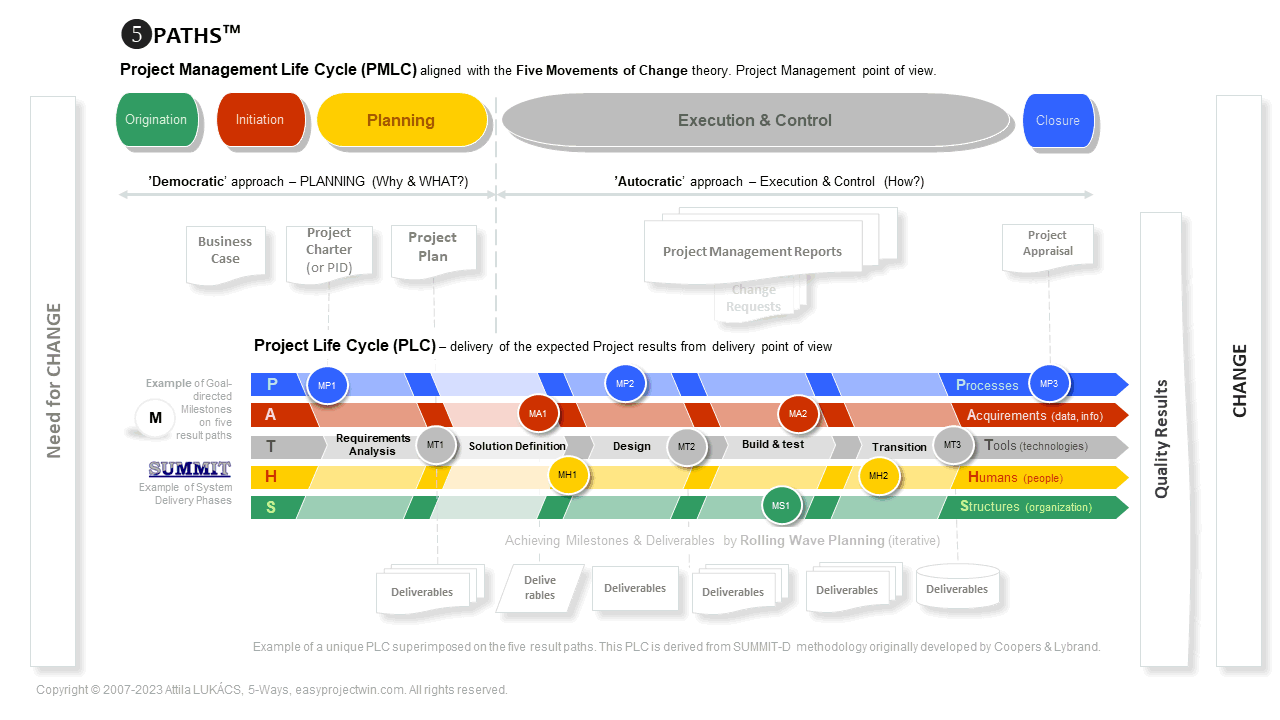❺PATHS™ Project Management Philosophy
❺PATHS™ Project Management Philosophy
 Ⓟ Processes | Ⓐ Acquirements | Ⓣ Technologies | Ⓗ Human resources | Ⓢ Structures
Ⓟ Processes | Ⓐ Acquirements | Ⓣ Technologies | Ⓗ Human resources | Ⓢ Structures

❺PATHS™ Project Management philosophy and methodology is fundamentally based on the fusion of the western Goal-Directed Project Management approach and the ancient eastern 'Five States of Change' (or rather 'Five Movements of Change') theory.
The five phases of Project Management Life Cycle (❺PATHS™ PMLC) are aligned with the principles and five elements (㊍ ㊋ ㊏ ㊎ ㊌) of the holistic Chinese 'Five States of Change' philosophy.
This ancient eastern theory depicts the elements/movements of the change in the order of natural lifecycle from beginning to completion.
There are also other important sources applied such as Silva's Mental Screen Technique (Mind Control Concept) and the Responsibility Assignment Matrix (RAM) of Summit-D Systems Delivery methodology to make our approach more efficient, practical and understandable.
The term FIVE PATHS basically refers to the five essential result paths of a goal-directed, result-driven project.
Please note that the letters of mnemonic acronym 'PATHS' also refer to the five elements/phases of PMLC, just in another order (SAHTP).
The five result PATHS are the following:
P
path
Development and change of PROCESSES
A
path
Development and change of DATA, REPORTS and KNOWLEDGE
T
path
Development and deployment of
APPLICATIONS, SYSTEMS, and architectures
H
path
Development of Human SKILLS and Resource Management
S
path
Development of ORGANIZATIONAL and TEAM structures
 Ⓟ Ⓐ Ⓣ Ⓗ Ⓢ / IDEAL / SMART
Ⓟ Ⓐ Ⓣ Ⓗ Ⓢ / IDEAL / SMART

My first project was in 1993. I managed it without any methodological background, using simple sequential, task-driven thinking. Then, I met GDPM in 1998.
From 1999 to 2011, I studied and researched ancient cultures back to 5,000 years, including Taoism, the book 'I Ching' and the 'Five States of Change' theory.
In 2005, I had a dream. I saw the fusion of the best recent Western project management methodology elements with ancient Eastern management philosophies.
The people listed below influenced me greatly to create a structured, logical, flexible approach and framework to Enterprise Project Management.
Thanks to Tom Graves for his impressive essay 'Five Elements to Model Workplace Dynamics' published in 2002. In 2005, this essay illuminated how to combine the five elements theory with GDPM basics.
Thanks to the developers of the New York State Project Management Guidebook. This open guidebook also influenced the development of the 5-PATHS methodology framework.
Thanks to Allan Elder's "Five Elements of a Project" essay. Allan's five project elements point out the essence of the Project Management. "#3 - One Accountable Entity"
Thanks to Jose Silva's 'Mental Screen' technique of his Mind Control method. This technique aligned with my Goal-Directed based, Success-Oriented Project Management philosophy.
Thanks to György Törő, who introduced the GDPM basics in 1998. I appreciated his great ideas, instructions, and help in real-life Project Management. 'A Project has only ONE Project Manager'
Thanks to Erling S. Andersen, Kristoffer V. Grude, Tor Haug, Rodney Turner, and Mike Katagiri for the fantastic GDPM philosophy
Attila Lukács
Owner of 5-Ways Lp., creator and developer of ❺PATHS™
❺PATHS™ Project Management Life Cycle corresponds to the 'Five States of Change' theory in the order of NATURAL life cycle from beginning to completion. The ancient five elements are percieved here as dynamic states and qualities of Change (default interpretation).
The letters of PATHS are sorted here according to the natural life cycle (S A H T P).
Please note that 5-PATHS™ differentiates between Project Management Life Cycle (PMLC) and Project Life Cycle (PLC) as terms used commonly in project management methodologies. PMLC refers to the delivery of the project from management point of view. On the contrary, PLC refers to the expected project results from delivery point of view utilizing Project Management components, elements, stages, processes, and tools. Project life cycles may vary from the nature of the project.

The most important components of our methodology correspond to the five elements listed in the table below.
As far as 5-PATHS components are concerned the ancient five elements are percieved as physical things, subtsances.
The order of the five elements are aligned here with the mnemonic acronym 'PATHS' instead of 'SAHTP' (order of letters according to the natural life cycle phases).